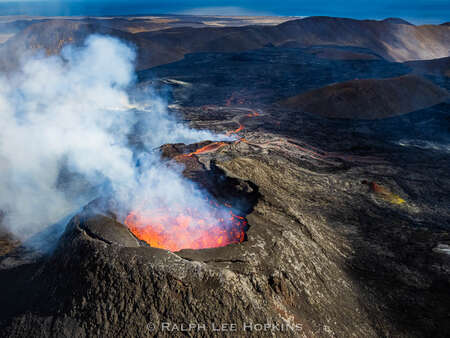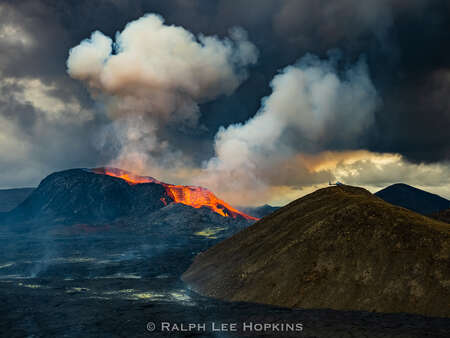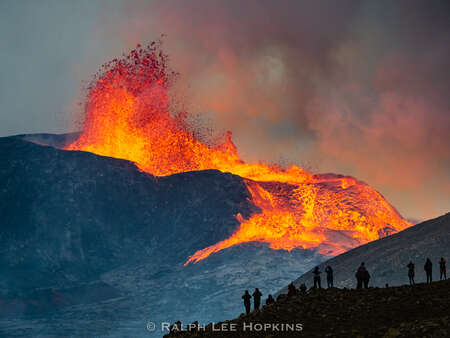It’s not every day that you get to trek to an active volcano erupting lava at the surface of the Earth. After watching live webcams at home in North Carolina since the eruption began on March 19th, 2021, I couldn’t wait to fly to Iceland. Only one problem: the pandemic.
Fast forward to June. I’m finally in Iceland to witness the eruption. Like a pilgrim climbing to a scared site for worship, I was led by friends from Reykjavik making their 10th trek. I couldn’t believe my eyes when the volcano first came into view.
Swarms of earthquakes along the Reykjanes Peninsula foretold that an eruption was imminent not far from Reykjavik. The activity started as linear fissure eruptions with curtains of lava being ejected into the air. In only a matter of days the action transformed into multiple vents ejecting lava fountains. Weeks later the activity shifted to one central crater, that volcanologists call a spatter cone, as blebs of lava (called spatter) weld together growing the rim.
Once at the top of the observation hill I found watching the eruption mesmerizing. It’s like being in a slow-motion movie. The situation begged for video and time lapse to capture the motion and explosive activity. What a great opportunity to put the in-camera functions of the OM-D E-M1 Mark III to work.
I’ve been here a week now and the activity is changing day-by-day. In fact, the trail to the observation hill has now been partially covered by lava and is no longer accessible.
The pulse of the volcano has changed, from episodic events every 10-15 minutes to constant effusive eruptions of flowing lava from the central crater. As I write this, lava continues to flow around 12 cubic meters per second, and now covers more than 3 square km. The total estimated volume is over 63 million cubic meters.
How long it will the eruption continue? No one can predict for sure, not even the Icelandic volcanologists and seismologists who spend their lives studying the dynamics of Iceland’s volcanic activity. The chemical signature of the magma indicates a deep source, boiling up to the surface from the mantle perhaps more than 12 miles (20 km) deep. This suggests the eruption will be long-lived.
Words can’t adequately describe the sounds, the smells, and thrill of experiencing the raw power of Mother Earth. Hopefully these images will help tell the story of geology in action!
Instagram: @ralphleehopkins
Ralph Lee Hopkins travels to the world’s wild places with Lindblad Expeditions and National Geographic. As Director of Expedition Photography for the National Geographic fleet he has photographed expeditions from the Arctic to the Antarctic and points in between over the last 30 years.




